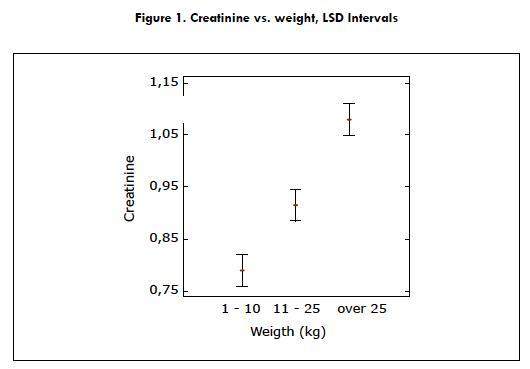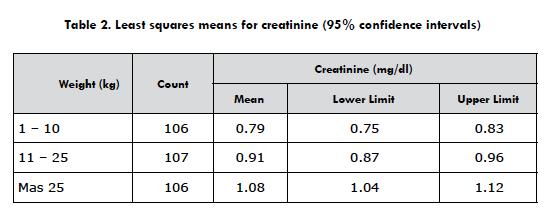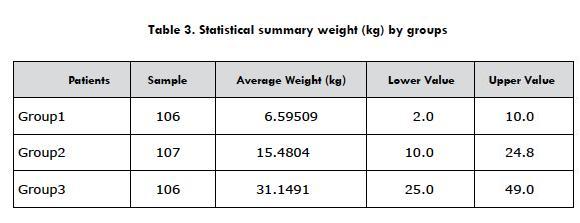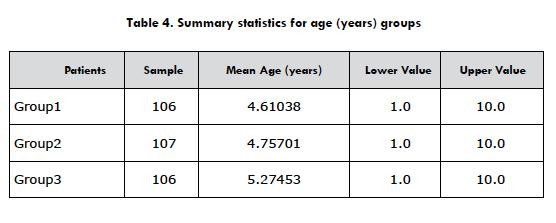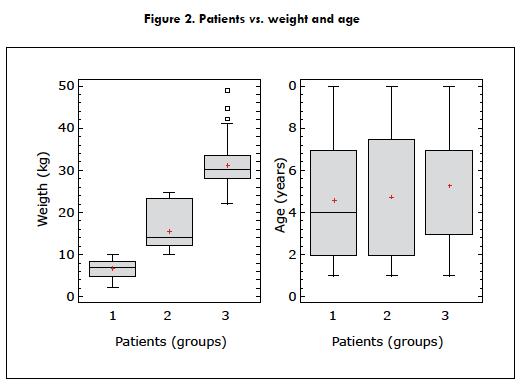Services on Demand
Journal
Article
Indicators
-
 Cited by SciELO
Cited by SciELO -
 Access statistics
Access statistics
Related links
-
 Cited by Google
Cited by Google -
 Similars in
SciELO
Similars in
SciELO -
 Similars in Google
Similars in Google
Share
Revista de Medicina Veterinaria
Print version ISSN 0122-9354
Rev. Med. Vet. no.27 Bogotá Jan./June 2014
Standardization of Serum Creatinine Levels in Healthy Dogs Related to Body Weight at the South Valley of Aburra, Colombia
Paola Catherine Báez Suárez1 / Cristhian Alberto Cabra Martínez2 / Isabel C. Ruiz3
1 Médica veterinaria, Esp. MSc. Miembro del grupo de investigación en salud animal: GIVET, Corporación Universitaria Lasallista, Caldas, Colombia.
pabaez@lasallista.edu.co
2 Médico veterinario. Msc. Miembro del grupo de investigación en salud animal: GIVET, Corporación Universitaria Lasallista, Caldas, Colombia.
cricabra@lasallista.edu.co
3 Médica veterinaria. Esp. Miembro del grupo de investigación, INCA CES, Facultad de Medicina Veterinaria y Zootecnia, Universidad CES, Envigado, Antioquia, Colombia.
iruiz@ces.edu.co
Received: January 22 th, 2014. Accepted: April 30th, 2014
How to cite this article: Baez Suarez PC, Cabra Martinez CA, Ruiz IC. Standardization of serum creatinine levels in healthy dogs related to the body weight at the South Valley of Aburra, Colombia. Rev Med Vet. 2014; (27):33-40.
Abstract
Currently there are no serum creatinine reference values in Colombia for healthy dogs related to body weight; there are only available foreign studies. The objective was to determine serum creatinine values in healthy dogs related to body weight at the South Valley of Aburra. There were sampled 320 healthy dogs and divided into three groups related to the body weight according to the Kennel Club classification as follows: 1-10 kg, 11-25 kg and over 25 kg. In order to determine their health status, their medical records were revised and a complete physical examination was performed. Subsequently, a blood sample was taken to measure the creatinine levels. Statistically significant differences were found (p<0.05) among the three groups. This article presents evidence to classify serum creatinine values related to body weight in dogs, which could allow veterinarians to have a better reference value for assessing kidney function.
Keywords: Glomerular filtration, muscle metabolism, renal function, serum creatinine, dogs
Estandarización de los valores séricos de creatinina en perros sanos con relación al peso corporal en el sur del Valle de Aburra
Resumen
Actualmente no se cuenta con valores de referencia de creatinina sérica en Colombia en caninos sanos con relación al peso corporal. Solo se tienen los estudios foráneos. El objetivo central fue determinar los valores séricos de creatinina en perros sanos según el peso corporal en el sur del Valle de Aburrá. Se muestrearon 320 perros clínicamente sanos, los cuales se dividieron en tres grupos según el peso corporal de acuerdo con la clasificación del Kennel Club, 1-10 kg, 11-25 kg y mayores de 25 kg. Se realizó análisis de la historia clínica y un examen físico completo para determinar su estado de salud. Posteriormente, se tomó la muestra de sangre para la medición de creatinina. Se encontraron diferencias estadísticas significativas (p < 0,05) entre los tres grupos. Este artículo presenta evidencia para clasificar los valores de creatinina sérica según el peso corporal, lo que permite a los médicos veterinarios tener un mejor referente para la evaluación de la función renal.
Palabras clave: Filtración glomerular, función renal, metabolismo muscular, creatinina sérica, perros.
Padronização de creatinina sérica em cães saudáveis em relação ao peso corporal, no sul do Vale do Aburrá
Resumo
A medição da creatinina sérica é um dos parâmetros atualmente utilizados na prática clínica pra avaliar a função renal em cães, isto é possível já que a creatinina é um componente do metabolismo muscular a qual é filtrada livremente pelos glomérulos, permitindo deste jeito estabelecer de forma geral a taxa de filtração glomerular e assim mesmo a da função renal. Atualmente não há valores de referência pra creatinina sérica na Colômbia em cães saudáveis em relação ao peso corporal, só ha estudos estrangeiros. Objetivo: Determinar os valores séricos de creatinina em cães saudáveis segundo seu peso corporal no Sul do Valle do Aburra. Foram amostrados 320 cães saudáveis, os quais foram divididos em três grupos, segundo o peso corporal de acordo com a classificação do Kennel Club, 1-10 kg, 11-25 kg e mais de 25 kg. Foi realizada a análise da história clínica e um exame físico completo para determinar seu estado de saúde; em seguida, tomou-se a amostra de sangue para a medição da creatinina. Foram encontradas diferenças estatisticamente significativas (p < 0,05) entre os três grupos. Este artigo apresenta evidências para classificar valores de creatinina sérica segundo o peso corporal, o que poderia permitir aos médicos veterinários ter uma melhor referência ao avaliar a função renal.
Palavras chave: a função renal, cães, creatinina sérica.
INTRODUCTION
The assessment of renal function is critical for evaluating the general health status of canines. It is mainly made by levels of serum creatinine, urea, and electrolytes in blood. Creatinine levels take primary importance since it is considered the most widely used marker for measuring glomerular filtration rate, the basic unit of the renal system (1).
A large population of dogs and cats is affected by kidney disease (2). The main clinical signs found are vomiting, diarrhea, anorexia, progressive weight loss and oral ulcerations; however, once the signs are manifested, most of the treatments may no longer be effective, and veterinarians must turn to specialized treatments. Because of this, veterinarians should apply specialized treatments such as peritoneal dialysis, hemodialysis or renal transplantation, and in many cases dogs must be euthanized (3,4).
One the most common parameters used in clinical practice to assess renal function in dogs is levels of serum creatinine. This is achieved thanks to the fact that creatinine is a component of the muscular metabolism that is freely filtered through the glomerulus, so its measurement allows to evaluate the glomerular filtration rate and, therefore, the renal function (2,4).
The purpose of this research is to standardize serum creatinine levels related to body weight in 320 clinically healthy dogs and it also provides a better tool for veterinarians to evaluate kidney function. Although it is known that most of the clinical signs are developed when the disease is advanced, the establishment of creatinine values could make it possible to detect an alteration in the renal function at an earlier stage and, that way, to install a better and effective therapy.
MATERIALS AND METHODS
The type of study performed in this research was descriptive, observational and cross-sectional and was approved by the Ethics Committee for Animal Experimentation from Corporación Universitaria Lasallista in 2011.
Blood samples were taken from the cephalic vein in 320 clinically healthy dogs in the South Valley of Aburra; data was organized into three different groups related to body weight according to the Kennel Club guidelines, as shown in Table 1. The statistical analysis revealed a significant difference among the three groups.
Location
Some samples were collected at the Clínica Veterinaria Hermano Octavio Martínez López, which belongs to the Corporación Universitaria Lasallista, located in the municipality of Caldas, Antioquia, and the other samples were collected from the Veterinary and Animal Science Center, which belongs to CES University, located in the municipality of Envigado, Antioquia. The South Valley of Aburra is located at 1328 meters above sea level and the weather is warm all year long.
Animals
Animals included in the study were clinically healthy dogs ranging between 1 and 10 years of age. A general physical examination was performed and the medical records were analyzed. The inclusion criteria were healthy dogs with no history of renal disease, determined by clinical charts, hemogram tests, creatinina levels, urea levels, urine analysis, and also normal body weight and diet. Dogs were categorized into three groups according to their body weight as follows:
-
1-10 kg
-
11-25 kg
-
25 kg
Dogs were weighed on the same digital scale and same equipment that was previously calibrated to avoid weight variations.
Sampling
Blood samples were taken from the cephalic vein (1 ml) and deposited in a test tube without anticoagulant for subsequent laboratory analysis; the Jaffé Technique was applied.
Statistical analysis
Serum creatinine concentrations (mg/dl) were analyzed in relation to body weight through an Analysis of Variance (ANOVA); there was used a confidence level of 95%, worked in Statgraphics Centurion program, license covered by the Corporación Universitaria Lasallista. Also, the Comparison Technique was used among homogeneous groups with least significant difference.
Results
Table 1 presents the analysis of variance for the variable Creatinine Response; it can be seen that the independent variable Animal Weight within the three levels is significant (p<0.05).
Figure 1 shows the serum creatinine mean values for each level of weight and intervals, based on Fisher's Method of Least Significant Difference (LSD). The intervals are constructed so that if 2 means are equal, intervals will overlap. Any pair of intervals that do not overlap corresponds to pairs on means values that have a statistically significant difference; therefore the three levels of animal weight differ significantly (p<0.05) with respect to creatinine, being the lowest creatinine value for a weight between 1 - 10 kg and greater value for more than 25 kg, evidencing statistic differences between the corporal weights.
Table 2 shows the mean creatinine level for each weight. The two columns on the right show the confidence interval from 95.0% for each of the means of each level.
Table 2 shows the lower value and the upper value in the different groups, showing the influence of body weight in each one of them. Table 3 shows the average weight of each of the three study groups of the study, and shows the lower and the upper weight levels and the weight mean of them. Table 4 shows a summary of statistics for age groups and the average age of each group that is not over 6 years old. Below whisker plot showing the mean, median and lower and upper quartiles.
DISCUSSION
He measurement of the level of serum creatinine is the most commonly used indicator to assess glomerular filtration rate and renal function (2). Creatinine is a small molecule derived from the cyclization of phosphocreatine and the creatine produced by the skeletal muscle, where 95% of the body's creatinine is located (1-3). Now that creatinine is freely filtered through the glomerulus without any phenomena of tubular reabsorption or secretion in dogs or cats, its measurement in blood is used to estimate kidney function (2). However, it is essential to take into account that creatinine is not the only parameter used to evaluate kidney function and that there are other tests available. Also, Cortadellas and Heine state that the test measurement of creatinine and urea as sole indicators of renal disease are not enough, since their increase is only detected when the functional renal mass is largely lost. While the objective of this research is not the classification of renal disease, the authors agree with the statements from the abovementioned authors, and researchers expect that the standardization of serum creatinine values related to body weight will allow veterinarians to make better decisions.
The wide range of body mass in dogs has caught the attention of many researchers who have been interested in evaluating potential physiological consequences that this variation could represent (5). One of the aspects to investigate is the concentration of creatinine, since its endogenous production depends primarily on muscle mass (6).
Some authors such as (7) reported that the regular creatinine value is in the range from 0.5 to 1.5 mg/ dl; however, in a study conducted in Venezuela by Castellanos et al. (6), statistically significant differences were found between the variables serum creatinine and body weight, although the author does not recommend generalizing these results because the environment can influence these values. The research showed statistically significant differences among the three groups, according to tables 2 and 3. In the first group of animals from 1-10 kg (average 6.6 kg), minimum 2 kg up to 10 the range of creatinine was from 0.75 to 0.83 mg/ dl, mean age 4.6 years, range of creatinine (0.75 to 0.83 mg/dl).
In a research by Castellanos et al. (6), they reported creatinine values from 0.27 to 1.07 mg/dl for dogs under 10 kg; this value differs from the one found in the present investigation, which may be related to the breeds of dogs used in this study, tenure conditions, food and atmosphere (1,8).
The International Renal Interest Society (IRIS) sets values of creatinine from 0.6 mg/dl as a parameter to classify animals with renal disease, but the institution does not indicate the body weight importance related to creatinine values. This institution is responsible for classifying dogs and cats with kidney disease from early stages, allowing veterinarians to take therapeutic measures (9). It is true that a classification is very useful, for authors of this work it is important to consider body weight since, as evidenced, there is statistical significance in their actual research, according to Martínez (10), when this author indicated that veterinarians should analyze these values in daily life patients.
Hiene et al. (1) report as a reference value of serum creatinine a value of 0.4 mg/dl, which is much lower than those reported by previous authors.
In the second group, according to tables 2 and 3, the serum creatinine range obtained was 0.85 to 0.96 mg/dl, with an average weight of 15.5 kg, 10 kg as minimum value and 24.8 kg as maximum value, and an average age of 4.75 years. This group has similarity values as the results reported in the research by Castellanos et al. (2), wherein the results obtained were 0.88 mg/dl with a standard deviation of 0.3.
In the third group, dogs over 25 kg, a creatinine range from 1.04-1.12 mg/dl was obtained, with an average weight of 31.15 kg with a minimum of 25 kg and maximum of 49 kg, and an average of 5.3 years of age, showing a statistically significant difference compared to the previous two groups, which could indicate that it is important to categorize serum creatinine concentration according to body weight. In the study presented by Castellanos et al. (2), the minimum value was 1.11 mg/dl for this group, showing a higher value than the one found in the research, which may be due to the differences already mentioned by the author.
Craig et al. (11) reported in a study serum creatinine values in the groups from 26 to 45 kg and over 45 kg the following results: values between 0.6 to 2.01 mg/dl in the group of animals from 26 to 45 kg and a range from 0.88 to 1.82 mg/dl in the group of animals over 45 kg. It is worth noting that, according to the results of this study, none of the patients had creatinine greater than 1.6 mg/dl; it is observed that the maximum value reported by Craig et al. was 1.82. In the present study the result was 1.12 mg/dl but it should be taken into account that the animals weighted more (49 kg with an average of 31 kg) and this could cause higher serum creatinine values than those obtained. For the authors of this study it is essential for patients of this type of research to include healthy dogs which no evidence, not only by physical examination but also by additional tests, that they had not suffered from kidney diseases.
We recommend performing an analysis of the glomerular filtration rate for those animals whose serum creatinine value was out regarding the normal ranges reported in previous studies, as written by Von and Pressler (12).
According to the results of the study, it is recommended to include body weight as a reference to determine renal function in dogs. The authors also suggest that veterinarians should relate this to clinical charts and urea and urine analysis, among other tests that a veterinarian might consider necessary for the right treatments.
REFERENCES
1. Heine R, Lefebvre H. assessment of renal function. En Elliot J, Grauer G. Wsava Manual. 2nd ed. London: British Small Animal Veterinary Association; 2007. p. 117-125. [ Links ]
2. Cortadellas O. Estadificación y manejo de la enfermedad renal crónica. En: Cortadellas O. Manual de nefrología y urología clínica canina y felina. Zaragoza: Servet; 2010. [ Links ]
3. Chew J, Dibartola S, Schenck P. Canine and feline nephrology and urology. Missouri; 2011. p. 35 [ Links ]
4. Elliot J, Grauer G. Manual of canine and feline nephrology and urology. London: Bsva; 2007. [ Links ]
5. Heusner AA. Body mass, maintenance and basal metabolism in dogs 1991; [citado 2012 nov 23]. Disponible en: http://europepmc.org/abstract/MED/1941246/reload=0;jsessionid=zv4fRJc4gY6ABQaR5sm6.22 [ Links ]
6. Castellanos R. Estudio de valores referenciales para bioquímica sérica en población canina de la Parroquia San José. REDVET [internet]; 2010 [citado 19 de enero 2013]. Disponible en: http://www.veterinaria.org/revistas/redvet/n050510.html [ Links ]
7. Baptista R. Determinación de los niveles de creatinina sérica en canes [tesis de grado]. Santa Cruz de la Sierra: Universidad Autónoma Gabriel René Moreno [internet]; 2003. [citado 2012 oct 20]. Disponible en: http://www.fcv.uagrm.edu.bo/sistemabibliotecario/doc_tesis/BATISTA,%20RICARDO%20ABSTRATO%20TESIS-20101122-164027.pdf [ Links ]
8. Polzin D. Stagin of ckd based on plasma creatinine concentration [internet]. 2009; [citado 2012 nov]. Disponible en: http://www.iris-kidney.com/pdf/iris2009_staging_ckd.pdf [ Links ]
9. Martínez PP, Martínez IR, Martínez PP. Caracterización de la función renal en perros. Rev Med Vet [internet]. 2012;(23) [citado 2012 oct 21]. Disponible en: http://www.scielo.org.co/pdf/rmv/n23/n23a08.pdf. [ Links ]
10. Lyman J. Blood urea nitrogen and creatinine. Emerg Med Clin North Am. 1986; 4(2):223-33. [ Links ]
11. Craig A, Seguela J, Queau Y. Redefining the reference interval for plasma creatinine in dogs: effect of age, gender bodyweight and breed. American College of Veterinary Internal Medicine. 24th annual forum. Luisville; 2006. [ Links ]
12. Von H, Pressler M. An overview of glomerular filtration rate testing in dogs and cats.National institute of health [internet]. Vet J. 2011;188(2):156-65 [citado 2012 dic]. Disponible en: http://www.ncbi.nim.gov/pmc/article/pmc2980797/pdf/nihms206318.pdf [ Links ]














